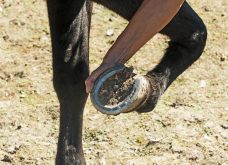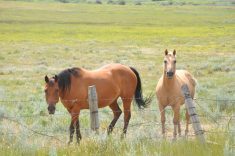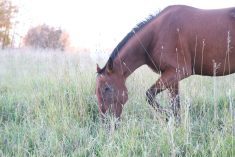At its most basic level, longeing (pronounced lunging) is a seemingly simple exercise. It asks a horse to move in circles around a handler.
However, execution of this exercise can be either very beneficial or very detrimental to the horse, depending on “how” it is done. How a horse carries its body as it travels on the circle is of much greater value to developing the horse than is how many times it is circled, how fast it is going or what equipment used.
The design of the circle itself presents the greatest gymnastic challenge for a horse moving around on a circle. The natural tendency of a horse as it moves in a circle is to lean inward and fall onto its inside shoulder. The amount of lean increases as the circle becomes smaller and the horse’s speed increases. As the horse leans, it is placed in an unstable position, a position it would not willingly maintain for many strides under usual circumstances.
Read Also

Pig transport stress costs pork sector
Popular livestock trailer designs also increase pig stress during transportation, hitting at meat quality, animal welfare and farm profit, Agriculture and Agri-Food Canada researcher says
Ideally a gentle curvature of the spinal column, mirroring the circle, while the horse holds an upright body carriage is sought. When the horse’s body is in this position, its back preferentially becomes rounded, and its posture improves. This proper body carriage is a powerful gymnastic exercise for the horse as it develops new core muscles through correct, nourishing movement.
A horse does not automatically bend at the end of a longe line. Although it might bend the neck under restraint or side reins, it does not follow that it will correctly bend the remainder of its spinal column and back.
- More ‘Horse Health’ with Carol Shwetz: Reducing risk of injury or sickness when trailering horses
Without proper, gentle schooling most horses will lean inward. Another common fault is the horses that drop their croup and turn their body outwards/opposite to the circle’s line, resisting their handler.
Either way, the kinematics of the limbs are no longer aligned symmetrically with the ground surface and as the “leaning” hooves impact the ground surface, they turn flat, inducing compressive and torquing forces on the surfaces of the articular cartilage, soft tissues, and ligaments.
Travelling in circles in improper posture for any length of time, especially with speed can cause severe damage to the joints and soft tissue of a horse’s leg. Young horses and larger horses are especially vulnerable to injury from improper techniques. Longeing a horse on a small circle for half an hour or more can place enormous stress and strain on tissues, doing irreparable harm, especially to young horses whose legs are not yet fully developed.
Done properly, longeing is a highly advanced and effective tool for developing and educating a horse. Practising proper alignment, correct form and posture, and rhythmic cadence are key elements critical to capturing the value of this practice. Safety for both the horse and handler are inherent in such a practice. The horse learns to organize its body in relation to the handler’s position and body language. Although voice commands, hand gestures, and whips may provide tools to guide the horse, it will ultimately be the human’s body language to which the horse connects and responds.
Since the longeing horse is acquiring physical prowess, much like a dancer, slow movements and careful practice at the horse’s natural cadence are necessary to set muscle patterns and memory. In the beginning, it is best to move the horse on the straight, and on very gentle curves.
Any system restricting or modifying the normal cycle of head and neck movements is going to modify limbs kinematics and vertebral column mechanism. Horses with restricted head and neck movement contract their backs and heavily weight their forehand. In doing so the horse overuses tissues ill prepared for such weighting and is more likely to become unsound over time.
When longed correctly horses become more physically and mentally engaged in this simple exercise, actively participating in their own well-being.




















